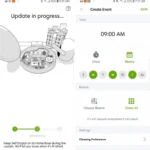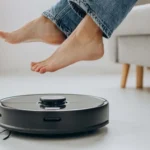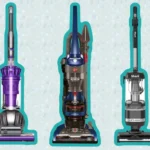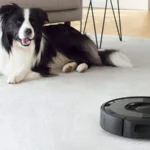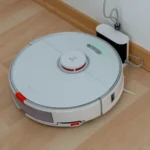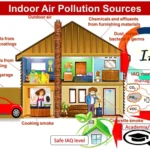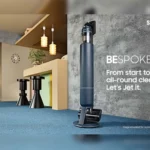Indoor air quality is often overlooked, but it is a crucial aspect of the overall health and comfort of a home. With the rise of smart technology, voice-controlled smart vacuum cleaners have emerged as a game-changer in indoor air quality maintenance. These devices not only make cleaning effortless but also help to reduce airborne particles and allergens. In this article, we will explore the benefits of voice-controlled smart vacuum cleaners in improving indoor air quality and how advancements in technology are set to revolutionize this area of home maintenance.
Why Indoor Air Quality is Important
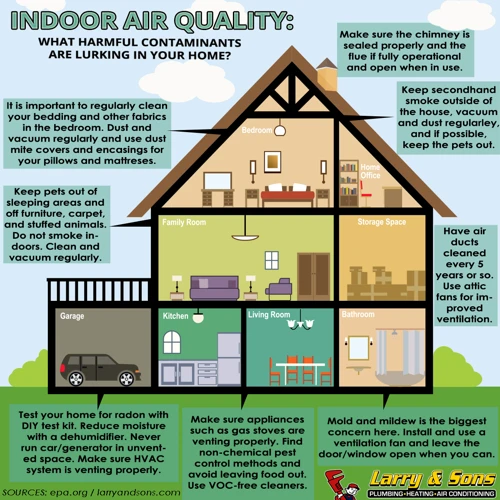
Indoor air quality is something that many people overlook but it is essential for our health and wellbeing. Poor indoor air quality can have detrimental effects on our health, especially for those who suffer from allergies or asthma. It can cause fatigue, headaches, and irritate the eyes, nose, and throat. With the average person spending 90% of their time indoors, it’s important that we take steps to improve the air we breathe in our homes.
One solution to improve indoor air quality is through the use of smart vacuum cleaners that are voice-controlled. These devices not only make cleaning more efficient and convenient but also help to reduce airborne particles, dust, and allergens. Voice control technology allows for hands-free cleaning, so even if someone has mobility issues, they can still keep their home clean and healthy.
Smart vacuum cleaners with voice control technology have features such as HEPA filtration systems, efficient cleaning brush rollers, and intelligent mapping and navigation. The HEPA filter traps particles as small as 0.3 microns, making it an excellent tool for reducing air pollution in indoor spaces. Efficient cleaning brush rollers are designed to collect dust, dirt, and pet hair with ease. Intelligent mapping and navigation allow the robot vacuum to systematically clean the entire space, while noise-canceling technology ensures quiet use.
Zone cleaning and app integration make smart vacuum cleaners even more convenient. You can set cleaning zones and cleaning schedules via the app, so the robot vacuum only cleans the areas where it’s needed. These features ensure that users can get the most out of their device, and it can be customized to meet their specific cleaning needs.
Voice-controlled smart vacuum cleaners are the future of house cleaning, and they come with numerous advantages over traditional vacuum cleaners. For example, they help pet owners to deal with pet hair and reduce the number of allergens in their environment. Smart vacuum cleaners with voice control technology are game-changers for those who want to maximize efficiency and have better accessibility to cleaning.
In the future, we can expect to see even more advancements in artificial intelligence and smart home integration, making smart vacuum cleaners even more powerful and convenient. With their ability to improve indoor air quality, save time, and reduce stress, it’s easy to see why smart vacuum cleaners are becoming increasingly popular.
Improving indoor air quality by using voice-controlled smart vacuum cleaners is an essential step towards achieving healthy homes. With their numerous features and capabilities, these devices are perfect for busy people who want a cleaner and healthier living environment.
The Effects of Poor Indoor Air Quality
Indoor air quality plays a crucial role in maintaining the health and well-being of individuals occupying a closed indoor space. Poor indoor air quality can have severe effects on one’s respiratory system, overall health, and can exacerbate existing medical conditions.
Indoor air pollutants may include dust, pollen, mold spores, pet dander, and even volatile organic compounds (VOCs) emitted from household items such as cleaning products, smoking, or cooking. These pollutants can trigger various allergic reactions, asthma attacks, or respiratory issues, especially in vulnerable groups such as seniors, children, and individuals with weakened immune systems.
It is thus essential to ensure that indoor air quality is not compromised, and one of the ways to achieve this is by using smart vacuum cleaners with voice control. According to a recent article on Smart vacuum with voice control, these advanced devices can efficiently remove the pollutants and improve indoor air quality.
Smart vacuums equipped with HEPA filtration systems are a game-changer for individuals with allergies or asthma, as they can trap minute particles, as small as 0.3 microns, that a conventional vacuum cleaner would miss out on. Efficient cleaning brush rollers can remove pet hair and dander, which can significantly reduce the negative effects on indoor air quality.
Intelligent mapping and navigation systems and zone cleaning features can ensure that cleaning is done effectively and on a schedule while minimizing the release of dust and other airborne particles. Smart vacuum cleaners with noise-canceling technology can make cleaning hassle-free, without the noise pollution of traditional vacuums.
Smart vacuum cleaners with voice control can make cleaning more accessible, efficient, and less taxing on individuals. They can effectively contribute towards reducing indoor air pollutants and improving air quality. Adopting these devices can be especially beneficial for pet owners, who can check out an article detailing the advantages of smart vacuum cleaners with voice control.
The future of smart vacuum cleaners with voice control is also promising, with advancements in artificial intelligence, as discussed in Voice activated smart vacuum cleaners are the future of cleaning and seamless smart home integration, enabling remote access and control.
It is evident that conventional vacuum cleaners are not enough to tackle indoor air pollutants, and smart vacuum cleaners with voice control can make a difference in both cleaning efficiency and improving indoor air quality.
How Smart Vacuum Cleaners Help
Smart vacuum cleaners are a fantastic addition to any home, and they play a crucial role in improving indoor air quality. The dust, dirt, and allergens that accumulate on carpets and floors can have a significant impact on the quality of the air we breathe. Smart vacuums aid in removing these potentially harmful elements from our homes in a powerful and efficient way.
As part of their advanced technology, these devices offer several benefits compared to traditional cleaning methods. With these vacuums’ help, homeowners can breathe easier by reducing the number of indoor allergens that may cause asthma and other breathing issues.
The cleaning process is more efficient since smart vacuums use advanced sensors to navigate around obstacles with ease. With their intelligent mapping and navigation, they know precisely where they have cleaned, where to go next, and which areas need extra attention. This feature maximizes cleaning efficiency while minimizing the effort required to clean.
Smart vacuums also come with an app designed to integrate cleaning schedules into a user’s lifestyle. The app allows users to schedule routine cleaning or spot-cleaning of specific areas, which makes cleaning a hands-free experience. As a result, users have more free time to focus on other tasks, making cleaning less of a chore.
With advanced voice control features, homeowners can clean their homes without the need to physically operate the device. Using simple voice commands, the smart vacuum can be easily directed to move to specific locations, such as cleaning under the bed, sofa or in the kitchen. It also allows users to manage different vacuuming modes, such as carpet, hard floor, and spot cleaning, simply by using their voice.
Thus, the advantages of smart vacuums over traditional cleaning methods are clear. They offer more efficient cleaning with less human effort and more excellent accuracy. Smart vacuums provide better protection for those with allergies, asthma, and other breathing issues by efficiently removing airborne particles that cause harm. They also help to maximize a homeowner’s free time by automating the cleaning process.
To understand more about the impact of voice control on smart vacuums or improve accessibility cleaning with smart vacuum voice control, check out our other articles on /smart-vacuum-voice-control/, /maximizing-efficiency-smart-vacuum-voice-control/, /advantages-smart-vacuum-voice-control/, /smart-vs-traditional-vacuum-cleaners/, and /improving-accessibility-cleaning-smart-vacuum-voice-control/.
Voice Control Advancements
The advancements in voice control technology have revolutionized the home cleaning industry, making it easier to maintain better air quality. Through the use of voice commands, users can instruct their smart vacuums to clean specific areas of their homes without having to lift a finger. This technology has come a long way over the years and has continued to improve year after year.
With the latest advancements in voice control, you can now use simple, everyday language to control your smart vacuums. Instead of needing to remember specific phrases or commands, you can simply say “clean the living room” and the device will understand what you mean. It’s like having your own personal cleaning assistant at your beck and call!
Voice control advancements have brought additional functionality to smart vacuums. For example, some vacuums now offer real-time mapping and navigational assistance that can help optimize cleaning routes and allow you to monitor the progress of the cleaning process from afar. This can help you get a more complete clean while being able to check on the progress of the cleaning process.
Another impressive voice control feature is the ability to set up cleaning schedules in advance. With just a few simple voice commands, you can set up daily or weekly cleaning schedules for any room or area of your home, making for a cleaner and healthier environment all year round.
Voice control advancements have greatly improved the functionality of smart vacuums, significantly simplifying the cleaning process while also improving air quality. Users now have access to seamless voice control functionality that allows them to take full advantage of advanced features, making it easier to get a thorough clean that’s tailored to their unique needs. As voice control technology continues to evolve, we can expect to see even more innovative features added to smart vacuums, paving the way for an even easier and more efficient way to clean our homes.
Key Features of Voice Controlled Smart Vacuum Cleaners
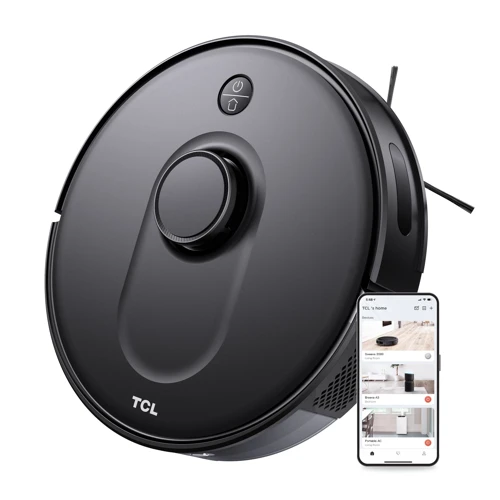
Smart vacuum cleaners have come a long way in terms of functionality and convenience. With the advent of voice control technology, the capabilities of these devices have expanded considerably. Here are some of the key features of voice-controlled smart vacuum cleaners that make them so effective at improving indoor air quality:
HEPA Filtration Systems: High Efficiency Particulate Air (HEPA) filters are incredibly effective at trapping tiny airborne particles, such as dust, allergens, and pet dander. Many smart vacuum cleaners come equipped with HEPA filtration systems which can improve overall air quality by reducing the number of particles circulating in the air.
Efficient Cleaning Brush Rollers: The brush rollers on smart vacuum cleaners are specially designed to optimize cleaning efficiency. They can move smoothly over different floor types and can effectively pick up dirt, dust, and debris. As a result, the cleaning process is more thorough, leaving a room cleaner than ever before.
Intelligent Mapping and Navigation: Some smart vacuum cleaners are equipped with advanced mapping and navigation systems that enable them to clean more efficiently. They can map out a space and determine the best cleaning path, as well as avoid obstacles and return to their charging station when they need to recharge.
Noise-Canceling Technology: The noise level of traditional vacuum cleaners can be a nuisance, but smart vacuum cleaners often come with noise-canceling technology. This means that they operate more quietly and do not disturb the peace in your home. As a result, you can clean your home anytime without worrying about disturbing anyone.
Zone Cleaning and App Integration: Many smart vacuum cleaners allow for zone cleaning, where you can designate specific areas for cleaning. This allows you to focus on areas that need cleaning the most, without cleaning areas that don’t require attention. Additionally, some smart vacuum cleaners can be controlled using a mobile app, allowing you to adjust settings, set schedules, and monitor cleaning progress from anywhere.
Voice-controlled smart vacuum cleaners are loaded with features that make them effective at improving indoor air quality. From HEPA filtration to noise-canceling technology and app integration, these devices are designed to make your life easier and your air cleaner.
HEPA Filtration Systems
One of the key features that make voice-controlled smart vacuum cleaners effective in improving indoor air quality is their HEPA filtration systems. High-Efficiency Particulate Air (HEPA) filters are designed to trap tiny airborne particles that other filters would miss. In fact, HEPA filters can capture particles as small as 0.3 microns with an efficiency rate of up to 99.97%.
This is particularly beneficial for people who suffer from allergies and asthma, as airborne pollutants can trigger attacks. The HEPA filter in a smart vacuum cleaner acts as a barrier, preventing these particles from being released back into the air, resulting in cleaner and healthier air quality.
Smart vacuum cleaners with HEPA filtration systems are especially helpful for people who have pets. Pet allergens such as dander, fur and saliva can remain in the air and cause allergic reactions for individuals who are sensitive to them. But with HEPA filters, the vacuum cleaner can trap these tiny particles while cleaning, reducing the amount of allergens in the air.
HEPA filtration systems in smart vacuum cleaners require minimal maintenance. Vacuum cleaners with these filters usually have a sensor that alerts you when it’s time to replace the filter. The replacement is simple and can be done in less than a minute, ensuring your vacuum cleaner continues to maintain high air quality.
Smart vacuum cleaners are designed to make our lives easier, and their HEPA filtration systems take that convenience one step further by improving indoor air quality. The existence of these filters allows people with allergies and asthma to breathe easier, making their homes a safer and healthier place to live.
Efficient Cleaning Brush Rollers
One of the key features that sets voice controlled smart vacuum cleaners apart from traditional vacuums is the use of efficient cleaning brush rollers. These rollers are designed to quickly and effectively clean a variety of surfaces, from carpets to hardwood floors.
Unlike traditional vacuums that use simple bristle brushes, smart vacuums use advanced technology to agitate and lift dirt and debris from floors. The brush rollers on these vacuums are outfitted with powerful motors and specialized design to enhance their cleaning abilities.
These rollers are able to extract dirt and debris from deep within carpet fibers, pulling out even the most stubborn dirt and pet hair. They also work well on hard floors, quickly picking up dust, dirt, and debris without damaging delicate surfaces.
One of the benefits of efficient cleaning brush rollers is their ability to detach and clean easily. This makes maintenance a breeze and ensures that the vacuum continues to operate at peak efficiency. Most smart vacuums even come with self-cleaning brush rollers, which use powerful suction to remove any hair or debris that gets tangled up during cleaning.
Efficient cleaning brush rollers are a crucial component of any voice controlled smart vacuum cleaner. They help to ensure that floors are cleaned thoroughly and efficiently, without damaging delicate surfaces or leaving dirt behind. With advanced features like self-cleaning and motorized brush rollers, smart vacuums are quickly becoming a must-have for anyone looking to improve their indoor air quality and keep their home clean and healthy.
Intelligent Mapping and Navigation
Smart vacuum cleaners equipped with intelligent mapping and navigation are revolutionizing the way we clean our homes. These features allow the vacuum cleaner to move around the home in a systematic and efficient manner, without bumping into obstacles or missing areas.
Intelligent mapping involves the use of sensors and cameras to create a map of the home’s layout. The vacuum cleaner can then use this map to plan the most efficient cleaning path, ensuring that every part of the home is covered. This not only saves time, but also ensures that no area is left uncleaned.
Navigation features allow the vacuum cleaner to move around the home with precision, avoiding obstacles and navigating around furniture. This means that you don’t have to worry about the vacuum getting stuck under a chair or running into a table leg.
These features also improve the overall cleaning performance of the vacuum cleaner. By knowing the layout of the home and the location of furniture, the vacuum cleaner can clean around and underneath objects with ease. This ensures that dirt and dust are removed from all areas, including those that are hard to reach with a traditional vacuum cleaner.
These features also make cleaning more convenient. The vacuum cleaner can be set to clean when you are not at home, and can be programmed to clean specific areas at certain times. This means that you can come home to a clean house without having to lift a finger.
The combination of intelligent mapping and navigation in smart vacuum cleaners takes convenience, efficiency, and cleaning performance to the next level. These features make cleaning easier and more thorough than ever before, providing a cleaner home and better indoor air quality for you and your family.
Noise-Canceling Technology
In addition to HEPA filtration and efficient cleaning brush rollers, voice controlled smart vacuum cleaners now come equipped with noise-canceling technology. This feature keeps the noise levels of the vacuum at a minimum, allowing you to clean your indoor space without disturbing other members of your household or even your neighbors. The technology is designed to detect the noise levels in your home and reduce them accordingly, without affecting the vacuum’s cleaning performance.
Noise pollution can be a significant contributor to poor indoor air quality, especially for individuals who are sensitive to loud sounds. Noise-canceling technology, therefore, represents a significant step forward in creating a clean and healthy home environment without sacrificing comfort.
The technology uses intelligent sensors that detect noises and adjusts the vacuum’s settings accordingly to minimize the amount of noise generated. This feature has the added benefit of reducing the amount of stress the user may experience while cleaning. By making the process of cleaning one’s home as quiet and stress-free as possible, the user can focus on the task at hand and perform a more thorough clean, leading to improved air quality.
Noise-canceling technology also has practical implications for individuals who suffer from sleep disturbances or those who work from home. The quiet operation of a voice-controlled smart vacuum cleaner ensures that it won’t disturb your sleep or disrupt your workday.
The noise-canceling technology of voice-controlled smart vacuum cleaners offers a practical solution for maintaining a clean home environment without sacrificing comfort or disrupting the peace. It provides a stress-free and peaceful cleaning experience while ensuring that you are taking the necessary steps to improve your indoor air quality.
Zone Cleaning and App Integration
One of the key features of voice-controlled smart vacuum cleaners is their ability to perform zone cleaning, which allows users to designate specific areas of their home for cleaning. This is particularly useful for larger homes or homes with multiple floors, where users may want to clean one area at a time.
App integration is another important aspect of these devices, which allows users to control their vacuums remotely from their smartphones or other mobile devices. This means that users can start and stop their vacuum from anywhere, and can also schedule cleaning sessions in advance.
The combination of zone cleaning and app integration results in a powerful tool for improving indoor air quality. By using the app to create cleaning schedules and designating specific areas for cleaning, users can ensure that their home is consistently and thoroughly cleaned. This is especially important for those with allergies or respiratory issues, as consistent and thorough cleaning can help remove allergens, dust mites, and other airborne particles that can contribute to poor indoor air quality.
Additionally, app integration allows for real-time tracking of the vacuum’s progress, so users can ensure that no areas are missed. This is particularly useful for larger homes or homes with multiple floors, as it can be difficult to keep track of where the vacuum has already cleaned.
The combination of zone cleaning and app integration is a powerful tool for improving indoor air quality. By allowing users to designate specific areas for cleaning and control their vacuum remotely, these devices help ensure that air quality is maintained at a high level. As smart home technology continues to advance, it’s likely that these features will become even more sophisticated, further improving the ability of voice-controlled smart vacuum cleaners to keep our homes clean and healthy.
Voice Control and Improved Indoor Air Quality
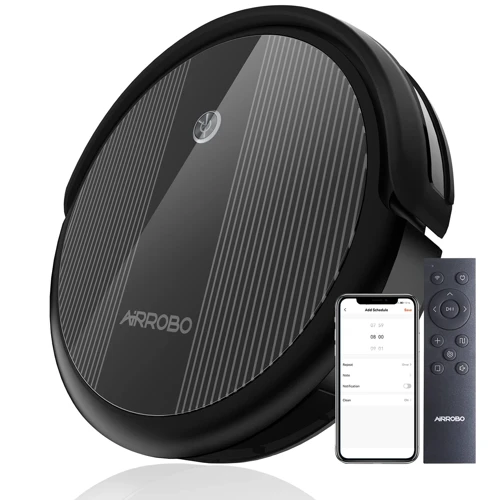
With the advent of voice-controlled smart vacuum cleaners, we can now take our cleaning to the next level. Not only can we control these devices with our voice, but they can also help improve indoor air quality. Here’s how:
Hands-Free Cleaning: One of the biggest advantages of voice-controlled smart vacuum cleaners is that they allow hands-free cleaning. With just a simple voice command, we can activate and control our vacuum cleaners. This means that we can clean our homes without touching potentially dirty surfaces on the vacuum cleaner itself. As a result, we can minimize the spread of bacteria and other airborne particles.
Reducing Airborne Particles: Another way that voice-controlled smart vacuum cleaners help improve indoor air quality is by reducing airborne particles. These devices are equipped with powerful suction systems that can effectively capture and remove dust, dirt, and other allergens from the air. By removing these particles, the air quality in our homes can be significantly improved.
Efficient Cleaning of Dust Mites and Allergens: In addition to removing larger particles from the air, voice-controlled smart vacuum cleaners are also highly effective at cleaning up smaller particles like dust mites and allergens. This is accomplished through the use of advanced HEPA filtration systems that can capture particles as small as 0.3 microns in size.
Better Overall Indoor Air Quality: By reducing the number of airborne particles in our homes and efficiently cleaning up smaller particles like dust mites and allergens, voice-controlled smart vacuum cleaners can help improve the overall air quality in our homes. This can have significant health benefits, particularly for people who suffer from allergies or respiratory issues.
Using a voice-controlled smart vacuum cleaner can help improve indoor air quality in several ways. By providing hands-free cleaning, reducing airborne particles, efficiently cleaning up dust mites and allergens, and improving overall air quality, these devices can help make our homes cleaner and healthier places to live.
Hands-Free Cleaning
It’s no secret that cleaning a home can be a daunting task. From sweeping and dusting to vacuuming, it can take up a significant portion of one’s time and energy. However, with the rise of technology, automated cleaning devices have made this task much more manageable. Voice controlled smart vacuum cleaners are at the forefront of this innovation, providing an easy and hands-free solution to cleaning our homes.
By incorporating voice commands, these devices eliminate the need for manual operation, allowing users to enjoy a convenient and seamless cleaning experience. With just a simple command, the smart vacuum cleaner can begin cleaning your home, all while you sit back and relax.
This type of hands-free cleaning is especially beneficial for individuals with physical limitations or disabilities that make conventional cleaning difficult. Smart vacuum cleaners with voice control help to level the playing field, giving everyone the opportunity to maintain a clean and healthy home environment.
Busy individuals can also benefit from this innovative technology. With voice control, users can multitask while their homes are being cleaned. Instead of stopping what they are doing to vacuum, they can simply give the command and let the smart vacuum cleaner do the work for them. This hands-free approach to cleaning is a game-changer for individuals with a busy lifestyle.
Voice controlled smart vacuum cleaners are designed to clean seamlessly and efficiently, making them ideal for maintaining a healthy indoor air quality. With the use of HEPA filtration systems, they can capture up to 99.97% of small particles, including allergens and dust mites. By reducing the number of airborne particles, these devices help to improve overall indoor air quality, providing a cleaner and healthier environment for individuals to breathe in.
All in all, voice controlled smart vacuum cleaners are a valuable addition to any home. With their advanced features and hands-free approach, users can enjoy a convenient cleaning experience that improves their overall indoor air quality, all while saving time and energy.
Reducing Airborne Particles
One of the major benefits of using a smart vacuum cleaner with voice control is the reduction of airborne particles. Typical household dust contains a range of particles, including dust mites, pet dander, pollen, and bacteria, that are small enough to be inhaled and cause respiratory irritations, allergies, and other health problems.
With the advent of advanced HEPA filtration systems, voice-controlled smart vacuum cleaners can remove up to 99.97% of particles as small as 0.3 microns. This is because, instead of just circulating the dust around like normal vacuum cleaners, they suck in the particles, and trap them within their filters. This ultimately results in cleaner air being pumped back out into the room.
Smart vacuum cleaners use a combination of different filtration systems to achieve this task. HEPA (High-Efficiency Particulate Air) filters are one of the most common types used. These filters effectively trap small particles, including allergens such as dust mites, pet hair and pollen, ensuring that they do not simply become re-dispersed into the air while cleaning.
Unlike traditional vacuum cleaners that require filters to be replaced periodically, the advanced HEPA filters in smart vacuum cleaners can be cleaned and reused, resulting in significant savings in time and money invested in maintaining these filtration systems.
Using a smart vacuum cleaner with voice control is an excellent way to reduce airborne particles in your home. By removing these often-invisible irritants, you can breathe cleaner, fresher air and reduce health risks associated with poor indoor air quality.
Efficient Cleaning of Dust Mites and Allergens
One major benefit of voice-controlled smart vacuum cleaners is their ability to efficiently clean dust mites and allergens from indoor air. Studies show that dust mites are a leading cause of allergies and asthma, and they can exacerbate other respiratory conditions. These microscopic insects thrive in warm and humid environments, making homes the perfect breeding ground.
To combat this problem, many smart vacuums come equipped with HEPA filtration systems. HEPA filters are designed to capture particles as small as 0.3 microns, which includes most dust mite allergens. This ensures that the dust and dirt collected by the vacuum won’t be recirculated back into the air, making it easier for individuals with respiratory issues to breathe more freely.
Additionally, smart vacuums often have intelligent mapping and navigation features that identify high-traffic areas and spots that may have more dust buildup. They can navigate around furniture and other obstacles with ease, ensuring a more thorough cleaning. Some smart vacuums even have zone cleaning capabilities that allow users to define specific areas that need deeper cleaning.
Incorporating voice control into smart vacuums provides an even more efficient cleaning experience. Users can simply speak a command to start the vacuum and control its movements, allowing for hands-free cleaning. This feature is especially helpful for those with respiratory issues who may have difficulty moving around and exerting physical effort.
The combination of HEPA filtration systems, intelligent navigation, and voice control makes smart vacuums a powerful tool for improving indoor air quality. By effectively removing the buildup of dust mites and allergens, individuals can breathe easier and experience a better quality of life.
Better Overall Indoor Air Quality
Voice controlled smart vacuum cleaners are an easy and effective way to improve the overall indoor air quality in your home. By utilizing advanced features such as HEPA filtration systems and efficient cleaning rollers, these devices are able to effectively remove harmful particles and allergens from the air.
HEPA filtration systems are one of the key features of voice controlled smart vacuum cleaners. These advanced filtration systems are designed to capture even the smallest particles in the air, including dust, pet dander, and allergens. This means that when you use a voice controlled vacuum cleaner, you can be confident that you are removing a significant amount of harmful particles from the air.
In addition to HEPA filtration systems, voice controlled smart vacuum cleaners also feature efficient cleaning brush rollers. These rollers are able to effectively remove dirt and debris from your floors, leaving your home cleaner and healthier. They are also designed to be gentle on delicate surfaces, making them perfect for use on hardwood floors and other sensitive flooring materials.
Perhaps one of the most exciting features of voice controlled smart vacuum cleaners is their intelligent mapping and navigation technology. This innovative technology allows the vacuum cleaner to map out your home and create a customized cleaning plan based on your specific floor plan. This means that the vacuum cleaner can clean your home with maximum efficiency, reaching every nook and cranny.
Noise in the home is a major cause of stress and anxiety, which is why many voice controlled smart vacuum cleaners now feature noise-canceling technology. This allows the vacuum cleaner to operate quietly, making it easy to clean your home without disrupting your daily routine.
Finally, voice controlled smart vacuum cleaners also feature zone cleaning and app integration capabilities. With zone cleaning, you can program your vacuum to clean specific areas of your home, allowing you to focus on high-traffic areas or other problem spots. And with app integration, you can easily control your vacuum cleaner through your smartphone, making it simple and convenient to keep your home clean and healthy.
Using a voice controlled smart vacuum cleaner is an easy and effective way to improve the overall indoor air quality of your home. By utilizing advanced features such as HEPA filtration systems, efficient cleaning rollers, and intelligent mapping and navigation, these devices are able to remove harmful particles and allergens from the air and keep your home clean and healthy.
The Future of Voice Controlled Smart Vacuum Cleaners
The future of voice controlled smart vacuum cleaners looks incredibly promising. With advancements in artificial intelligence, these devices are becoming more intelligent and efficient at cleaning. With the use of machine learning algorithms, they can even learn the cleaning preferences of homeowners and adjust their cleaning patterns accordingly.
Advancements in Artificial Intelligence
Artificial intelligence is playing a critical role in the evolution of voice-controlled smart vacuum cleaners. The technology allows the devices to perform tasks without human intervention and learn from past experiences. AI technology can help the vacuum cleaners navigate the environment better, identify the difference between dust and dirt, and more efficiently remove them.
New Smart Home Integration and Control
Smart home integration is another aspect where these devices showcase limitless potential. With the advent of smart home technology, smart vacuum cleaners can now operate within a broader network of smart devices, including smart speakers, thermostats, lighting systems, and security systems. This integration allows for all devices to work together seamlessly, improving efficiency and overall performance.
The convenience of voice control in smart home automation has made the use of these devices even more straightforward, as cleaning can be done simply by using voice commands or through the use of smartphone apps.
It’s intriguing to think that in the future these devices may have the capability to work autonomously without any human intervention. Self-recharging, emptying and maintenance features are just a few potential enhancements that could make the user experience even more convenient.
The future of voice-controlled smart vacuum cleaners is an exciting field to watch. Advancements in technology are continuously unlocking new possibilities for these machines, from more advanced machine learning algorithms to improved cloud integration in smart homes. It’s no exaggeration to say that these smart devices will soon become an integral part of our daily lives, helping us live and breathe easier than ever before.
Advancements in Artificial Intelligence
Over the years, the capabilities of voice-controlled smart vacuum cleaners have improved rapidly with the help of artificial intelligence (AI). Advanced algorithms have enabled these devices to learn from their environments and optimize their cleaning strategies. Some of the noteworthy developments in artificial intelligence that have contributed to the improvement of smart vacuum cleaners are:
Machine Learning: This technology enables vacuum cleaners to learn from their environment and adapt to it. It helps devices to recognize different surfaces, rooms, and objects and adjust their cleaning methods accordingly. Machine learning algorithms can also map out obstacles, remembering where to avoid or adjusting the device’s approach to them. As a result, these devices can provide a more personalized cleaning experience.
Deep Learning: Smart vacuum cleaners are now equipped with deep learning capabilities, which help them understand the context of a room better. These algorithms can identify patterns, textures, and colors in the environment more effectively and thereby help the device to adjust its cleaning strategies. For example, if the device notices an increase in pet hair on a particular day, it can automatically adjust its cleaning intensity.
Natural Language Processing: With the help of Natural Language Processing algorithms, users can now give voice commands in a more natural and conversational way. The devices can recognize different accents and dialects, filtering out background noise and interpreting voice commands accurately. This technology has made voice-controlled vacuum cleaners much more convenient to use.
Cloud Computing: To enhance the performance of smart vacuum cleaners, manufacturers have begun integrating cloud services into these devices. Cloud computing enables these devices to access data analytics, storage, and computing resources. This technology ensures that the vacuum cleaner is always up-to-date, improving the device’s overall performance.
The advancements made in artificial intelligence have taken voice-controlled smart vacuum cleaners to an entirely new level of efficiency and convenience. With the help of AI, these devices can now operate with greater autonomy, intelligence, and accuracy. With the continued evolution of AI, we can expect more exciting developments in the future that will make these devices even more beneficial for improving indoor air quality.
New Smart Home Integration and Control
As voice-controlled smart vacuum cleaners continue to improve, so do their integration with smart home technology. These new models now allow for integration with various smart home devices and systems, such as Amazon Echo, Google Home, and Apple HomeKit. This means that you can control your smart vacuum cleaner with just your voice, giving you a completely hands-free cleaning experience.
Smart home integration also allows for improved control over cleaning schedules and zones. With just a few taps on your smartphone or through voice commands, you can map out which areas of your home you want the vacuum to clean and when, which can save you both time and energy.
Plus, new smart home integration features also allow for easy monitoring and maintenance of your smart vacuum cleaner. You can easily track the vacuum’s cleaning history and see how well it has been performing, as well as receive alerts for when you need to replace the filter or brush roller.
With the advancements in smart home integration and control, it’s becoming easier and more convenient to keep your indoor air quality at its best. No longer do you have to worry about scheduling time for cleaning or breathing in poor air quality. With just a simple command or tap of a button, your smart vacuum cleaner will take care of it all, leaving you with fresh and clean air to breathe in your home.
Conclusion
In conclusion, it’s clear that voice-controlled smart vacuum cleaners have revolutionized the way we approach indoor air quality. With their HEPA filtration systems, efficient cleaning brush rollers, intelligent mapping and navigation, noise-canceling technology, and zone cleaning capabilities, these devices are designed to make cleaning easier, more efficient, and more effective than ever before.
Thanks to voice control advancements, users can now command their vacuum cleaner without ever having to touch a button, significantly reducing their exposure to airborne particles and other allergens. These devices are also highly beneficial for people with respiratory problems, as they provide an effective way to remove dust mites and other allergens from the air.
It’s also clear that the future of voice-controlled smart vacuum cleaners is bright, with many exciting advancements in artificial intelligence and smart home integration just around the corner. With these advancements, we can expect even more efficient and effective cleaning capabilities, further improving indoor air quality and overall quality of life.
Overall, if you’re looking to improve your indoor air quality and make cleaning easier and more efficient, a voice-controlled smart vacuum cleaner is an excellent investment. With its many features and capabilities, it’s sure to provide you with a cleaner, healthier, and more comfortable living environment for years to come.
Frequently Asked Questions
How does poor indoor air quality affect health?
Poor indoor air quality can cause a variety of health problems, including respiratory issues, headaches, fatigue, and allergies.
What is a HEPA filtration system?
A HEPA filtration system is a high-efficiency filter that can capture a high percentage of small particles, including dust, pollen, and pet dander.
How do smart vacuum cleaners with voice control work?
Smart vacuum cleaners with voice control can be controlled through voice commands using smart home devices like Amazon Alexa or Google Assistant.
What is intelligent mapping and navigation?
Intelligent mapping and navigation is a feature that allows the vacuum cleaner to map the layout of a room and navigate around obstacles for efficient cleaning.
Can smart vacuum cleaners with voice control clean carpets and hard floors?
Yes, most smart vacuum cleaners with voice control are designed to clean both carpets and hard floors.
How does noise-canceling technology work in smart vacuum cleaners?
Noise-canceling technology uses microphones and speakers to analyze and cancel out noise, making the vacuum cleaner run more quietly.
What is zone cleaning?
Zone cleaning is a feature that allows the vacuum cleaner to focus on cleaning specific areas of a room or home.
Do smart vacuum cleaners with voice control require Wi-Fi?
Yes, smart vacuum cleaners with voice control require a Wi-Fi connection to be controlled using smart home devices.
How do smart vacuum cleaners improve indoor air quality?
Smart vacuum cleaners with HEPA filtration systems can capture small particles like dust and pet dander, reducing airborne pollutants and improving indoor air quality.
Can smart vacuum cleaners with voice control be scheduled to clean specific areas at certain times?
Yes, most smart vacuum cleaners with voice control can be scheduled to clean specific areas at certain times using app integration features.


